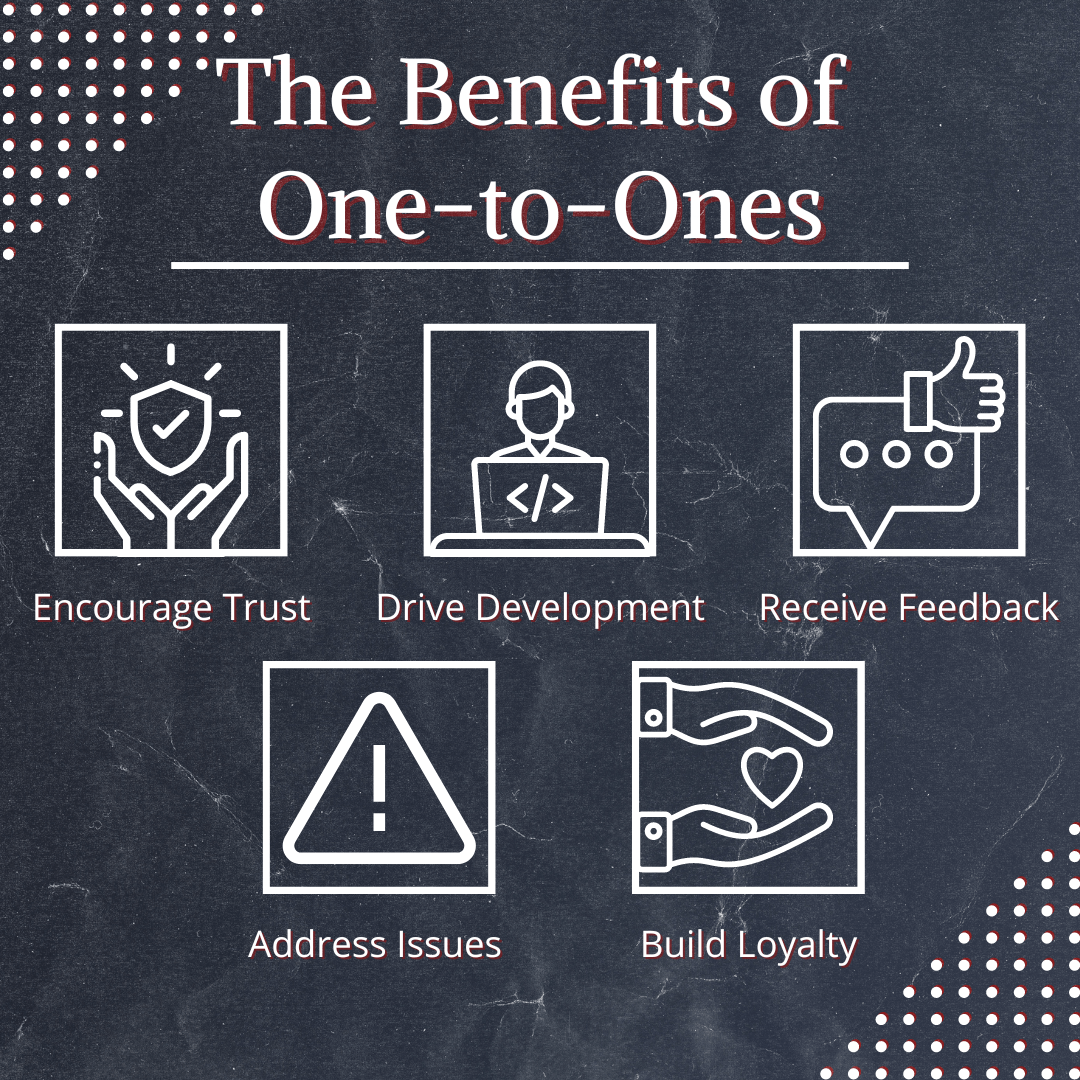In a time when mass resignations and job dissatisfaction are on the rise, leading one-to-one meetings with your team members is a great way to build an environment of loyalty. Showing your employees you value their input by giving them your time and attention can help ensure they remain dedicated to the success of your business.
One-to-ones are widely acknowledged as a powerful tool for building relationships, increasing morale, and boosting productivity. However, these meetings are often the first casualty of a leader’s busy schedule.
For leaders ready to nurture happier and more productive working relationships, we’ve laid out what you can do to make one-to-ones a non-negotiable priority.
What Is a One-To-One?
At their core, one-to-ones are simply dedicated time for employees to meet with their manager without other teammates present. Many leaders use one-to-ones to focus on the employee’s overall development and discuss issues the manager may not be aware of. However, one-to-one meetings serve more purposes than just goal setting and goal tracking; leaders can also use them to ensure all team members are aware of information pertinent to their jobs.
Communicating important information via large team meetings or in passing around the office saves time in the short term, but it doesn’t allow for larger conversations. Your employees likely have their own concerns and questions, and they may not want to share those in a group setting. A one-to-one gives your workers the privacy to discuss their thoughts while also offering you valuable insight into your company’s culture and your employees’ wellbeing.

How Do One-To-Ones Help Employees?
During one-to-ones, employees can have a personal, private conversation with the person who will be most involved in their professional development—their manager. These meetings can help employees better understand their role in the company, what is expected of them, and how they can improve their performance. They can also be used to help your employees plan for their futures within the company—how do they want to advance and grow?
Additionally, one-to-one meetings help employees feel heard, something that remains important no matter how large your company grows. A dedicated time to share thoughts and ideas shows employees their input is valued and their feedback is appreciated. Happy workers are more productive—when employees are treated respectfully and fairly by their superiors, they’re likely to be more engaged and perform at a level that benefits the entire company.
How Do One-To-One Meetings Help Leaders?
One-to-ones aren’t just for the benefit of employees; leaders must also understand that one-to-ones are an essential tool for their overall success. One-to-one meetings are an opportunity for leaders to learn more about their employees. Asking questions about their motivations, their challenges, and whether they need more support to do their job can eliminate small issues before they become more disruptive.
Employee one-to-ones are also a chance for managers to understand how they can support their employees and inspire them to do their best work. Having these meetings regularly builds trust, and this trust empowers both parties to speak up when changes need to be made.
A Guide to Great One-To-Ones
One-to-ones are often less structured than formal meetings and treated as more of an open discussion about what the manager and employee need from each other. However, one-to-one meetings still require preparation to ensure they’re a productive use of time. No one likes meetings that could have been an email!
Set an Agenda
Before leading your one-to-ones, set a loose agenda. Consider the questions that need answers and the topics of conversation you can use to clarify your employees’ needs. The aim of your one-to-one will differ from employee to employee, but topics of discussion may include:
- Professional development goals: how do they envision the trajectory of their career? Do they need additional resources to learn a new skill?
- Feedback exchange: what can they improve upon? How can you better serve them as a leader?
- Emotional wellbeing: how have they been doing? What roadblocks or stressors are they experiencing?
- New employee check-in: how has their first week or month gone? From a first impression, where do they see the need for improvement within the company?
- Employee thoughts: do they have any issues, concerns, or questions? Do they need clarification, have a new idea, or have valuable insight to share?
At CEO Solutions, many of our clients find one-to-one meetings most useful when the employee’s agenda is the top priority. This allows you, as a business leader, to get the employee’s organic thoughts, as well as a great sense of “what’s really happening” in your organization.
Review Relevant Information
You should also prepare for one-to-one meetings by reviewing notes from previous meetings. Refresh yourself on important topics, like career goals, work assignments, or performance issues.
Be Transparent
Since your employees might be nervous about these meetings, it’s essential to be transparent. As a manager, you have the opportunity to set an example for your team by being honest and open about your feelings and perspectives. Your openness will help foster trust because employees know they can be honest with you without fear of judgment or consequences.
Improving Company Culture with CEO Solutions
There’s no denying it: one-to-one meetings create a culture of feedback and trust. When employees know their opinions are valued, they’re more engaged in their work and more likely to stay with a company long-term.
CEO Solutions clients are constantly reminded that happy and effective employees know three things:
- The specific expectations of their role
- That they’ll often get to work to their strengths and passions
- That their company cares about them
One-to-ones help confirm these truths.
And while one-to-ones are not a perfect fix for low employee morale, if used correctly, they are an incredibly useful tool in the workplace. Consider implementing regular one-to-one meetings with your team members to see how effective they can be—and reap the rewards that follow.
CEO Solutions provides peer-to-peer business owner and leader meetings to help you tackle issues and opportunities within your company. CEO Solutions also meets with our group members in a one-on-one meeting every month to focus specifically on their development. Whether you’re struggling to build a culture of loyalty or seeking professional development for your second-in-command, our peer groups can help. Meet with other owners who have faced—or are currently facing—similar issues and learn the tactics you need to grow a successful, scalable business. Become a member of CEO Solutions today, or visit our website to learn more.


